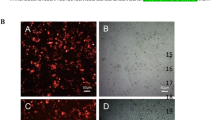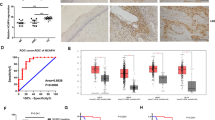Abstract
Tumor suppressor p53 functions are downregulated in most cervical cancers, because the product of human papilloma virus (HPV) oncogene E6 binds to and inactivates p53 by promoting its degradation. p73, a p53 homologue, is similar to p53 in structure and function but yet not degraded by HPV E6 gene product. In this study, we have developed a replication-deficient recombinant adenovirus, which expresses p73β (Ad-p73). Infection of human cancer cells with Ad-p73 results in several fold increase of p73β levels as well as its known target genes like p21WAF1/CIP1. Ad-p73-infected cells showed reduced cellular DNA synthesis, arrest in G1 phase of cell cycle and induction of apoptosis. Ad-p73 inhibited the growth of cancer cells of different types. More importantly, Ad-p73 inhibited the growth of cell lines carrying HPV E6 gene, which was introduced by stable integration, more efficiently in comparison to an Ad-p53. Furthermore, Ad-p73 also inhibited the growth of HeLa cells, a cell line derived from cervical cancer, very efficiently. The ability of Ad-p73 to inhibit the growth of HPV E6-expressing cells and HeLa cells correlated with the stable expression of functional p73 in the presence of E6. These results suggest that Ad-p73 could be used as a potential gene therapy agent against cervical cancer.
This is a preview of subscription content, access via your institution
Access options
Subscribe to this journal
Receive 50 print issues and online access
$259.00 per year
only $5.18 per issue
Buy this article
- Purchase on Springer Link
- Instant access to full article PDF
Prices may be subject to local taxes which are calculated during checkout








Similar content being viewed by others
Abbreviations
- HPV:
-
human papilloma virus
- Brdu:
-
bromodeoxyuridine
References
Beer-Romero P, Glass S and Rolfe M . (1997). Oncogene, 14, 595–602.
Blagosklonny M and El-Deiry WS . (1996). Int. J. Cancer, 67, 386–392.
Brinton LA . (1992). Epidemiology of Cervical Cancer – Overview: The Epidemiology of Human Papillomavirus and Cervical Cancer, Munoz N, Bosch F, Shah KV and Meheus A (eds). Oxford University Press: Oxford, pp. 3–23.
Bunz F, Dutriaux A, Lengauer C, Waldman T, Zhou S, Brown JP, Sedivy JM, Kinzler KW and Vogelstein B . (1998). Science, 282, 1497–1501.
El-Deiry WS, Tokino T, Velculescu VE, Levy DB, Parsons R, Trent JM, Lin D, Mercer WD, Kinzler KW and Vogelstein B . (1993). Cell, 75, 817–825.
Grenlee RT, Hill-Harmon MB, Murray T and Thun M . (2001). CA Cancer J. Clin., 51, 15–36.
Hamada K, Alemany R, Zhang WW, Hittelman WN, Lotan R, Roth JA and Mitchell MF . (1996). Cancer Res., 56, 3047–3054.
Haupt YR, Maya R, Kaza A and Oren M . (1997). Nature, 387, 296–299.
He TC, Zhou S, DaCosta LT, Yu J, Kinzler KW and Vogelstein B . (1998). Proc. Natl. Acad. Sci. USA, 95, 2509–2514.
Hollstein M, Sidransky D, Vogelstein B and Harris CC . (1991). Science, 253, 49–53.
Huh WK, Gomez-Navarro J, Arafat WO, Xiang J, Mahasreshti PJ, Alvarez RD, Barnes MN and Curiel DT . (2001). Gynecol. Oncol., 83, 370–377.
Jost CA, Marin MC and Kaelin WG . (1997). Nature, 389, 191–194.
Kaghad M, Bonnet H, Yang A, Creancier L, Biscan JC, Valent A, Minty A, Chalon P, Lelias JM, Dumont X, Ferrara P, McKeon F and Caput D . (1997). Cell, 90, 809–819.
Kamijo T, Weber JD, Zambetti G, Zindy F, Roussel MF and Sherr CJ . (1998). Proc. Natl. Acad. Sci. USA, 5, 8292–8297.
Kubbutat MGH, Jones SN and Vousden K . (1997). Nature, 387, 299–303.
Lechner MA and Laminis LA . (1994). J. Virol., 68, 4262–4273.
Levine AJ . (1997). Cell, 88, 323–331.
Lungu O, Sun XW, Wright TCJ, Ferenczy A, Richart RM and Silverstein S . (1995). Obstet. Gynecol., 85, 337–342.
Marin MC, Jost CA, Irwin MS, DeCaprio JA, Caput D and Kaelin WG . (1998). Mol. Cell. Biol., 8, 6316–6324.
Oliner JD, Pientenpol JA, Thiagalingam S, Gyuris J, Kinzler KW and Vogelstein B . (1993). Nature, 362, 857–860.
Orlow I, LaRue H, Osman I, Lacombe L, Moore L, Rabbani F, Meyer F, Fradet Y and Cordon-Cardo C . (1999). Am. J. Pathol., 155, 105–113.
Prabhu NS, Blagosklonny M, Zeng YX, Wu GS, Waldman T and El-Deiry WS . (1996). Clin. Cancer Res., 2, 1221–1229.
Prabhu NS, Somasundaram K, Satyamoorthy K, Herlyn M and El-Deiry WS . (1998). Int. J. Oncol., 13, 5–9.
Qu W, Jiang G, Cruz Y, Chang CJ, Ho GY, Klein RS and Burk RD . (1997). J. Clin. Microbiol., 35, 1304–1310.
Rose PG and Eifel PJ . (2000). Combined Modality Treatment for Carcinoma of the Cervix: Cancer, Principles and Practice of Oncology, DeVita V, Hellman S and Rosenberg S (eds). Lippincott-Raven: Philadelphia, PA, pp. 14:1–14:10.
Scheffner M, Munger K, Byrne JC and Howley PM . (1991). Proc. Natl. Acad. Sci. USA, 88, 5523–5527.
Somasundaram K and El-Deiry WS . (1997). Oncogene, 14, 1047–1105.
Somasundaram K, Jayaraman G, Williams T, Moran E, Frisch S and Thimmapaya B . (1996). Proc. Nat. Acad. Sci. USA, 93, 3088–3093.
Somasundaram K, MacLachlan TK, Burns TF, Sgagias M, Cowan KH, Weber BL and El-Deiry WS . (1999). Oncogene, 18, 6605–6614.
Stott FJ, Bates S, James MC, McConnell BB, Starborg M, Brookes S, Palmero I, Ryan K, Hara E, Vousden KH and Peters G . (1998). EMBO J., 17, 5001–5014.
Storey A, Thomas M, Kalita A, Harwood C, Gardiol D, Mantovani F, Breuer J, Leigh IM, Matlashewski G and Banks L . (1998). Nature, 393, 229–234.
Takimoto R, MacLachlan TK, Dicker DT, Niitsu Y, Mori T and El-Deiry WS . (2002). Can. Biol. Ther., 1, 177–186.
Tsao YP, Huang SG, Chang JL, Hsieh JT, Pong RC and Chen SL . (1999). J. Virol., 78, 4983–4990.
Wu GS and El-Deiry WS . (1996). Clin. Cancer Res., 4, 623–633.
Yatabe N, Kyo S, Kondo S, Kanaya T, Wang Z, Maida Y, Takakura M, Nakamura M, Tanaka M and Inoue M . (2002). Cancer Gene Ther., 9, 624–630.
Zeng YX, Somasundaram K and El-Deiry WS . (1997). Nat. Genet., 15, 28–32.
Zhang Y, Xiong Y and Yarbrough WG . (1998). Cell, 92, 725–734.
Acknowledgements
This study was supported by a grant from Defence Research and Development Organization (DRDO), Government of India. SD is supported by a fellowship from Council for Scientific and Industrial Research (CSIR), Government of India.
Author information
Authors and Affiliations
Corresponding author
Rights and permissions
About this article
Cite this article
Das, S., El-Deiry, W. & Somasundaram, K. Efficient growth inhibition of HPV 16 E6-expressing cells by an adenovirus-expressing p53 homologue p73β. Oncogene 22, 8394–8402 (2003). https://doi.org/10.1038/sj.onc.1206908
Received:
Revised:
Accepted:
Published:
Issue Date:
DOI: https://doi.org/10.1038/sj.onc.1206908
Keywords
This article is cited by
-
Virus against virus: strategies for using adenovirus vectors in the treatment of HPV-induced cervical cancer
Acta Pharmacologica Sinica (2021)
-
Expression quantitative trait loci in long non-coding RNA PAX8-AS1 are associated with decreased risk of cervical cancer
Molecular Genetics and Genomics (2016)
-
IER3 is a crucial mediator of TAp73β-induced apoptosis in cervical cancer and confers etoposide sensitivity
Scientific Reports (2015)
-
Human papillomavirus 16E6 oncogene mutation in cervical cancer
Chinese Journal of Cancer Research (2009)
-
Antisense RNA directed to the human papillomavirus type 16 E7 mRNA from herpes simplex virus type 1 derived vectors is expressed in CaSki cells and downregulates E7 mRNA
Virology Journal (2007)



